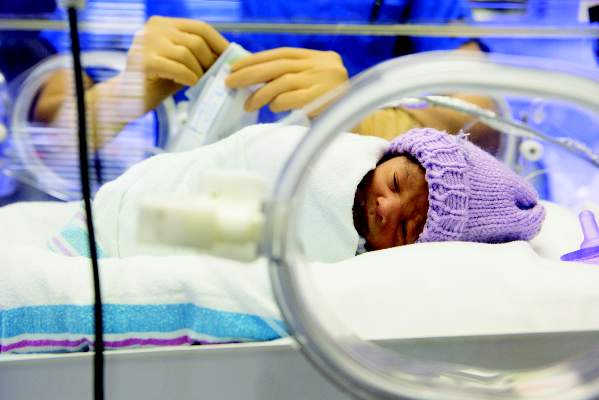User login
Early elective deliveries – inductions and cesarean deliveries before 39 weeks’ gestation – account for nearly 9% of the singleton births paid for under the Medicaid program, according to an analysis published in the December issue of Health Affairs.*
The rate of early elective deliveries has improved over the last few years, falling by nearly a third among Medicaid-financed births between 2007 and 2011 (Health Aff. 2014;33:2170-8).
Medicaid medical directors in Ohio and Minnesota, working with staff members of AcademyHealth, compared birth certificate data and hospital records from 22 states to determine the rate of early elective deliveries from 2010-2012. Twelve states also provided trend data or 2007-2011.
Of the more than 800,000 singleton births paid for by the Medicaid program across the 22 states, about 32% were elective deliveries and nearly 9% were early-term elective deliveries.
Elective cesarean deliveries were more common than were elective labor inductions before 39 weeks’ gestation. And early elective deliveries increased with maternal age. Mothers older than 34 years had the highest rate at 12.7%. Mothers younger than 20 years had the lowest rate at 6.6%. Early elective deliveries were also higher among women with a history of cesarean delivery.
Over the last few years, there has been a steady push to reduce nonmedically indicated early deliveries. Both the American College of Obstetricians and Gynecologists and the Society for Maternal-Fetal Medicine say that early elective deliveries are not appropriate.
The federal government is also getting involved. In 2012, the Centers for Medicare & Medicaid Services joined other federal health agencies to launch the Strong Start for Mothers and Newborns Initiative, aimed at reducing early elective deliveries. And decreasing the rate of early elective deliveries is a priority measure in the CMS initial Core Set of Health Care Quality Measures for Adults Enrolled in Medicaid.
More than 20 state Medicaid programs have also implemented policies that discourage early elective deliveries, ranging from clinical education to partnering with hospitals on “hard stop” policies that bar scheduling of deliveries before 39 weeks without documentation of medical necessity.
While the rate of early elective deliveries has been falling since 2007, the researchers could not pinpoint which strategy is most effective, since most of the efforts are new.
*Correction, 1/30/2015: An earlier version of this story misstated the definition of early elective deliveries.
mschneider@frontlinemedcom.com
On Twitter @maryellenny
Early elective deliveries – inductions and cesarean deliveries before 39 weeks’ gestation – account for nearly 9% of the singleton births paid for under the Medicaid program, according to an analysis published in the December issue of Health Affairs.*
The rate of early elective deliveries has improved over the last few years, falling by nearly a third among Medicaid-financed births between 2007 and 2011 (Health Aff. 2014;33:2170-8).
Medicaid medical directors in Ohio and Minnesota, working with staff members of AcademyHealth, compared birth certificate data and hospital records from 22 states to determine the rate of early elective deliveries from 2010-2012. Twelve states also provided trend data or 2007-2011.
Of the more than 800,000 singleton births paid for by the Medicaid program across the 22 states, about 32% were elective deliveries and nearly 9% were early-term elective deliveries.
Elective cesarean deliveries were more common than were elective labor inductions before 39 weeks’ gestation. And early elective deliveries increased with maternal age. Mothers older than 34 years had the highest rate at 12.7%. Mothers younger than 20 years had the lowest rate at 6.6%. Early elective deliveries were also higher among women with a history of cesarean delivery.
Over the last few years, there has been a steady push to reduce nonmedically indicated early deliveries. Both the American College of Obstetricians and Gynecologists and the Society for Maternal-Fetal Medicine say that early elective deliveries are not appropriate.
The federal government is also getting involved. In 2012, the Centers for Medicare & Medicaid Services joined other federal health agencies to launch the Strong Start for Mothers and Newborns Initiative, aimed at reducing early elective deliveries. And decreasing the rate of early elective deliveries is a priority measure in the CMS initial Core Set of Health Care Quality Measures for Adults Enrolled in Medicaid.
More than 20 state Medicaid programs have also implemented policies that discourage early elective deliveries, ranging from clinical education to partnering with hospitals on “hard stop” policies that bar scheduling of deliveries before 39 weeks without documentation of medical necessity.
While the rate of early elective deliveries has been falling since 2007, the researchers could not pinpoint which strategy is most effective, since most of the efforts are new.
*Correction, 1/30/2015: An earlier version of this story misstated the definition of early elective deliveries.
mschneider@frontlinemedcom.com
On Twitter @maryellenny
Early elective deliveries – inductions and cesarean deliveries before 39 weeks’ gestation – account for nearly 9% of the singleton births paid for under the Medicaid program, according to an analysis published in the December issue of Health Affairs.*
The rate of early elective deliveries has improved over the last few years, falling by nearly a third among Medicaid-financed births between 2007 and 2011 (Health Aff. 2014;33:2170-8).
Medicaid medical directors in Ohio and Minnesota, working with staff members of AcademyHealth, compared birth certificate data and hospital records from 22 states to determine the rate of early elective deliveries from 2010-2012. Twelve states also provided trend data or 2007-2011.
Of the more than 800,000 singleton births paid for by the Medicaid program across the 22 states, about 32% were elective deliveries and nearly 9% were early-term elective deliveries.
Elective cesarean deliveries were more common than were elective labor inductions before 39 weeks’ gestation. And early elective deliveries increased with maternal age. Mothers older than 34 years had the highest rate at 12.7%. Mothers younger than 20 years had the lowest rate at 6.6%. Early elective deliveries were also higher among women with a history of cesarean delivery.
Over the last few years, there has been a steady push to reduce nonmedically indicated early deliveries. Both the American College of Obstetricians and Gynecologists and the Society for Maternal-Fetal Medicine say that early elective deliveries are not appropriate.
The federal government is also getting involved. In 2012, the Centers for Medicare & Medicaid Services joined other federal health agencies to launch the Strong Start for Mothers and Newborns Initiative, aimed at reducing early elective deliveries. And decreasing the rate of early elective deliveries is a priority measure in the CMS initial Core Set of Health Care Quality Measures for Adults Enrolled in Medicaid.
More than 20 state Medicaid programs have also implemented policies that discourage early elective deliveries, ranging from clinical education to partnering with hospitals on “hard stop” policies that bar scheduling of deliveries before 39 weeks without documentation of medical necessity.
While the rate of early elective deliveries has been falling since 2007, the researchers could not pinpoint which strategy is most effective, since most of the efforts are new.
*Correction, 1/30/2015: An earlier version of this story misstated the definition of early elective deliveries.
mschneider@frontlinemedcom.com
On Twitter @maryellenny
FROM HEALTH AFFAIRS
Key clinical point: Clinicians need to do more to curb early elective deliveries.
Major finding: Between 2007 and 2011, early elective deliveries in Medicaid fell 32%, but still account for nearly 9% of births.
Data source: Retrospective descriptive study covering 839,688 Medicaid-covered singleton births during 2010-2012.
Disclosures: The study was funded by the Agency for Healthcare Research and Quality, the Centers for Medicare & Medicaid Services, and the Health Resources and Services Administration. The study authors reported having no financial disclosures.

